Brief

한눈에 보기
- Growth creates complexity and complexity kills growth. Nearly all fast-growing companies drift toward bureaucracy, losing the ability to capture the benefits of size and act with speed.
- Micro-battles rapidly address how to win with customers and how to scale winning solutions across the organization.
- Through micro-battles, companies can develop the leading, learning and scaling behaviors needed to revive insurgency and achieve sustainable, profitable growth.
Why is it that most companies—89% in our research—can’t sustain profitable growth over 10 years? The answer is the growth paradox: Growth creates complexity and complexity is the silent killer of growth.
By definition, every great company starts as an insurgent. It's at war against its industry on behalf of underserved customers. The founding team's wildest ambition is to become the incumbent in the industry that it has newly defined, and enjoy the benefits of scale and leadership. But this comes at a tremendous cost. As the company expands and professionalizes, the resulting complexity erodes its insurgent mission, its obsession with the front line and its owner's mindset—qualities at the heart of its Founder's Mentality®. This drift toward mediocrity is the default path—and absent leadership intervention, it's inevitable (see Figure 1).
Without management intervention, most successful companies follow the default path to struggling bureaucracy
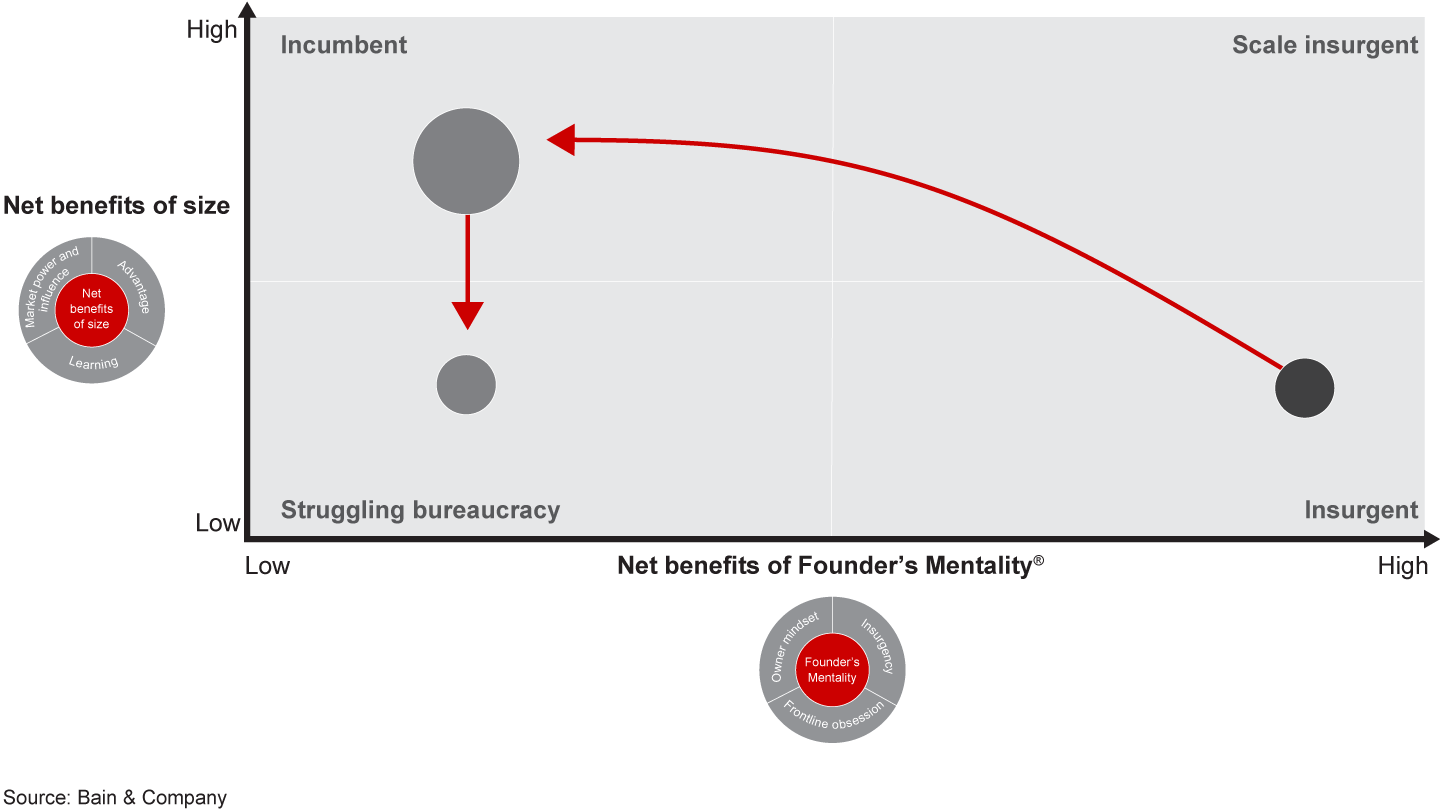
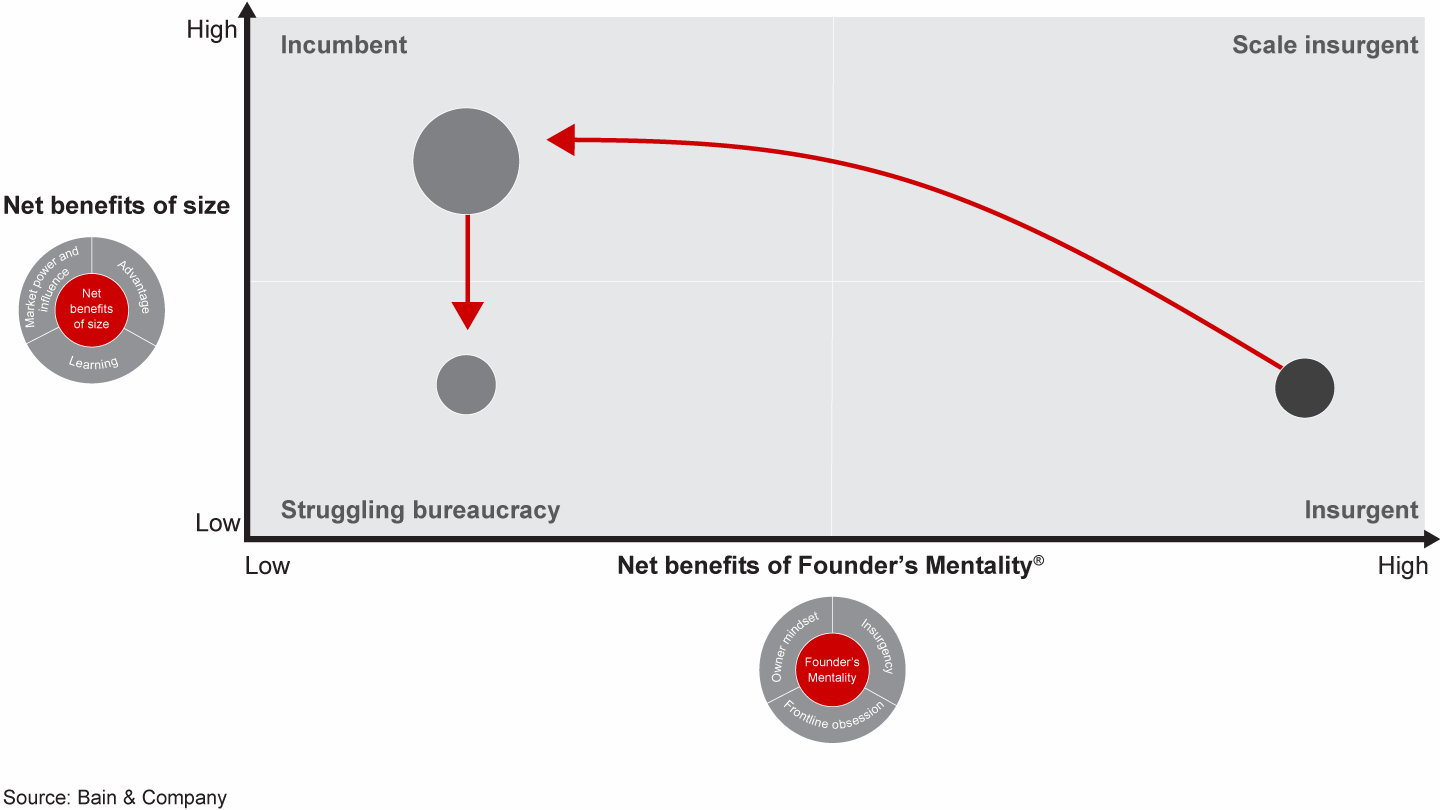
That intervention must be led by the CEO, and reinvigorating a company's Founder's Mentality is one of the hardest acts in business. Boiled down, it amounts to rediscovering the art of getting stuff done—or, more precisely, getting the right stuff done at speed. If strategy a generation ago was about systematically capturing the benefits of scale, strategy now is about scale and speed—being big and fast. Speed demands that incumbent companies create a system to rapidly refocus on the right priorities, generate solutions and scale those solutions across the firm. At the same time, they need a catalyst to spur profound behavioral change at all levels of the company—especially at the top. Micro-battles—discrete, time-boxed initiatives that rapidly bring strategic choices to action and formulate ways to scale the results—are a potent way to transform both the organization and executive behavior. But before we go into how, it helps to look a little more closely at why so many companies get into trouble.
What goes wrong
Our book The Founder's Mentality digs deeply into why fast-growing companies slide down the default path. The short version is that complexity eats away at all three of the key characteristics of a founder-led company:
- Insurgency. A company with a strong Founder's Mentality has a clear sense of insurgency, the conviction that it can serve customer needs better and faster than anyone else. This translates into a bold insurgent mission that leads to extraordinary clarity about what has to be done and which capabilities must "spike" in order to deliver. The team knows that if it's world class at one, two or three of these capabilities, it will win, meaning it doesn't waste time worrying about anything else. But as the company grows, every function wants to be world class and each of them creates hundreds of initiatives to get there. The entire organization gets handcuffed by trying to do everything to pursue functional distinction and not enough to do what's right for the customer. Call it the tyranny of functional excellence.
- Frontline obsession. An obsession with the front line is another defining characteristic of an insurgent company. Insurgents know that a strategy doesn't exist unless it's translated into the routines and behaviors of those closest to the customer. But as the company brings in professionals to manage its growing scale, these people begin to believe they're more important than those who actually execute. We call this the rise of the professional managerial class.
The changes brought on by the professionals are subtle, but profound. First, instead of acting like founders and making problems smaller (so someone can take action after a meeting), leaders begin to reward those who make problems bigger. A local pricing problem, for instance, quickly becomes an organizational problem that demands an 18-month review. Second, rather than the opposite of simple being "complex," the opposite of simple becomes "advanced." If everything is advanced, who stops initiative overload by asking, "Yes this is nice, but it will add costs and slow us down, and maybe we should ask our customer if she wants to pay for it?" Finally, because the professionals don't always come from the front line, they have no interest in translating their decisions to frontline routines and behaviors. Strategy and organization discussions become horizontal and take place almost independently of customers and frontline people. - Owner's mindset. These problems eventually erode a company's essential owner's mindset—the notion that every decision, every dollar spent affects you personally. This feeling of ownership leads to what Georgetown University professor Cal Newport calls "deep work," or the kind of work that taps the unique talents of individuals to increase the value of the enterprise every day. Shallow work is everything else—the unnecessary "going through the motions" tasks, process and meetings that a complex bureaucracy encourages. As the owner's mindset disappears, no one takes accountability for how their ideas affect others' deep work; everyone is happy to create more and more shallow work because at least everyone looks busy. People forget that their purpose is to focus ruthlessly on delivering the insurgent mission to customers every day. In fact, the professionals often roll their eyes at such sentiment, confident that the institution has moved on from talking endlessly—and passionately—about customers. What chaos that created! It's easier to focus endlessly on horizontal discussions with your peers at the head office.
The goal: scale insurgency
The most successful companies fight back against these creeping forms of dysfunction by becoming what we call "scale insurgents." They build scale and achieve leadership economics without sacrificing the speed and insurgent energy that powered their steady growth.
The hallmark of these companies is that they're big and fast, marrying the cost benefits of scale with the speed needed to win in markets roiled by disruption. They do this by embracing what most companies hide from—conflict. Scale insurgents recognize that the only way to sustain success is to confront the three great conflicts every business faces and then resolve them on behalf of customers. Those conflicts are:
- Scale vs. intimacy. What benefits customers more, difference or sameness? The head of Indonesia for a global multinational might argue that its consumers would benefit if it delivers spicier soup than it does elsewhere, since Indonesians hate bland food. But the head of supply chain would counter that consumers benefit most from the cost benefits of scale, or sameness. The right debate will produce a compromise: "We will deliver spicier soup, but do we really need 52 kinds of mustard seed when 10 will do?"
- Disruption vs. routine. Innovation, speed and agility are critical insurgent qualities. But so are flawlessly executed routines. On a flight from London to Munich, for instance, you don't want to hear the pilot say, "Welcome to your flight. On our arrival to Munich, we'll be experimenting with an exciting new landing procedure we think holds great promise." Much of what a scale insurgent does, say 85%, is best done according to established, proven routines. The remaining 15% should disrupt the status quo to improve routines, create efficiencies, find new revenue streams and invent new businesses.
- Short term vs. long term. Companies are constantly working to balance these two imperatives. Someone should be losing sleep over tomorrow's trading numbers and someone should be thinking hard about how the company survives for the next two generations. Both demand resources and management attention, but striking the right balance is a daily exercise in conflict resolution.
Scale insurgents recognize that these balancing acts don't come naturally. In fact, the conventional wisdom of the professional managerial class is that these conflicts must be managed only by the senior team. All conflicts must rise to the top, slowing everything down as decisions get funneled up siloes like Yellowstone geysers. Success requires an intentional effort of leaders to encourage these debates where they pop up every day, so the right priorities and solutions emerge as a matter of course. That's where micro-battles come in.
Introducing Bain Micro-battles System℠
Micro-battles dial up a firm's metabolism in two ways—by sharpening and accelerating strategy and by forcing behavioral change (see Figure 2). Individual battles are tied directly to your most critical strategic priorities and address the biggest problems those initiatives face. They're almost always vertical—involving real customers, competitors and frontline employees. In organization and approach, these battles should look like microcosms of the company you want to become. They mimic the actions of a scale insurgent, which has an important follow-on effect. It helps teach the rest of the company, particularly top leadership, how to be faster, mission driven and focused on the customer. In this way, the micro-battles system is as much about solving specific problems as it is about changing behavior at the top to steadily transform the organization as a whole.
Micro-battles teach companies to win and scale
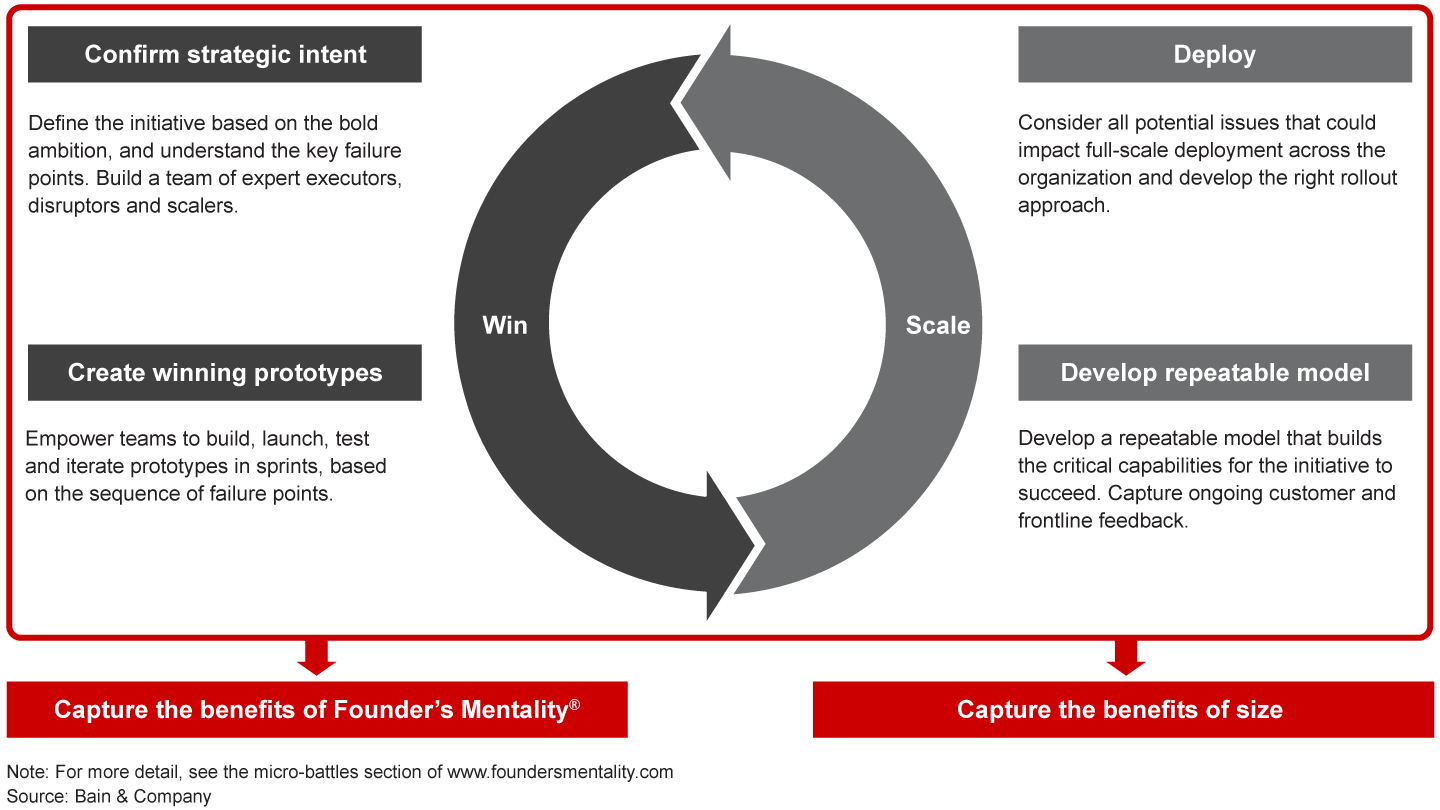
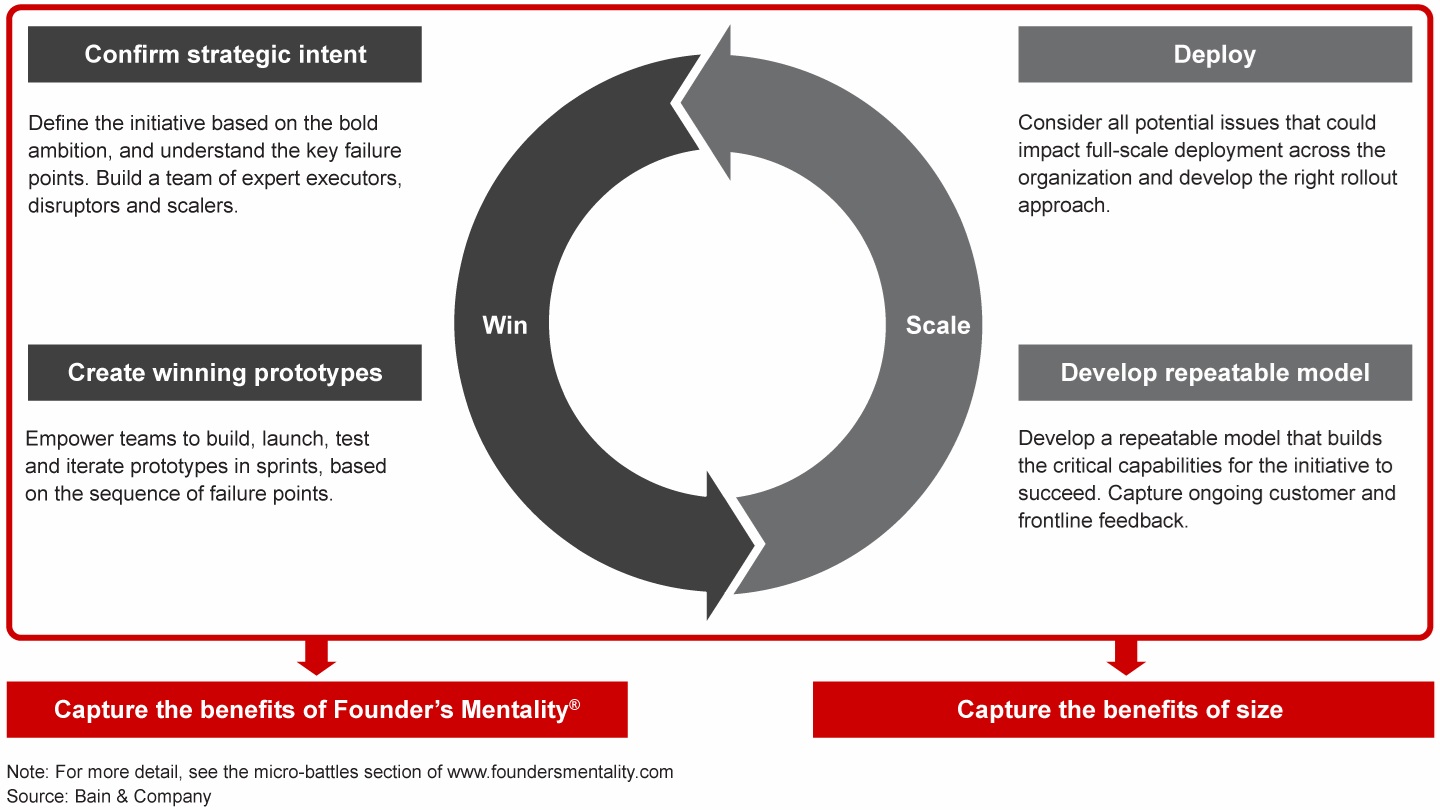
Let's look at how this works, first at the micro-battle level and then at the leadership level.
Winning and scaling
Individual micro-battles are staffed by small, cross-functional teams trained in Agile development techniques. These people are dedicated to the battle and drawn from across the organization as needed to solve a carefully defined problem. Importantly, they aren't led by top executives or staffers, but by those we call "franchise players"—the people within the organization who, by fighting for either scale or intimacy, deliver the insurgent mission directly to customers every day. Their job is to lead a team that will confront the three great conflicts mentioned above and resolve them on behalf of customers.
Micro-battles solve problems by iterating on prototypes in rapid cycles of test and learn. Teams working in Agile fashion begin with the "first failure point"—the most difficult issue the initiative faces—to avoid spending heavily on something that ultimately won't work. Micro-battles entail fast failure and adaptation, but the key is low-cost failure; you're trying to make cycle times so fast that you limit the cost of failure on each cycle of learning.
To some executives, this will sound like the many pilot programs they've launched over the years—only to watch them fizzle out. But micro-battles are different from pilots in several critical respects. Pilots typically succeed at first because they're overresourced and senior leaders are committed to doing whatever it takes to make them work. Then, when management teams try to scale the resulting innovation, they run into huge problems. The pilot has never been tested for transferability, meaning it might not work in the next city or with the next product. If it's not repeatable, it won't work at normal resource levels under normal business conditions. If you merely change a couple of conditions, the pilot fails to work. That gives all the naysayers in the organization their "I told you so" moment.
Micro-battles, on the other hand, anticipate these issues from the beginning. Each one is set up to do two things: win and scale. Winning means translating a strategic initiative into something that can be successfully prototyped and tested with customers. Scaling means rigorously testing that prototype for transferability and repeatability, while developing the repeatable model that can then be scaled across the company. We call the team running the micro-battle the "Win-Scale" team for this reason. From Day 1, its success depends on developing the right prototype that will scale.
Narrowing the aperture
An example will help illustrate what we mean. Let's say a global beauty-products company is losing share to rivals because it can't keep pace in digital sales. Top leaders launch an initiative to "win in digital," setting targets for regional e-commerce teams to increase sales at 5% above market growth. The problem is, the marketing and brand people still work in functional silos and the regions have wildly different views on the critical steps needed to solve the problem. After six months, they produce 20 regional initiatives with mixed results, making it hard to pinpoint a repeatable model that will work across the company.
Let's rewind and apply a micro-battles approach: The company spends the first week unpacking the digital consumer journey and realizes that the No. 1 reason customers are going elsewhere is that they're overwhelmed by the vast assortment of cosmetics the company offers online. Leadership launches a small, cross-functional team drawn from e-commerce, marketing and branding to take on a narrow question, "How can we make the selection process simpler for consumers?" The team focuses on one brand in one geography and prototypes a solution that helps customers narrow down their choice of products. By the fourth week, the results are promising, but before declaring victory, the company decides to test the solution in geographies two, three and four. Then comes the scaling questions: Should the company continue to roll out the repeatable model across geographies for this particular brand? Or should it scale the model across all brands or all digital marketing campaigns? This leads to more critical questions. What behaviors need to change to make the model work and what should the training agenda look like?
Disruption, execution and scaling
As we've worked with companies on what it takes to both win and scale, we've come to recognize that any system of scaling innovation has to draw upon a wide and diverse set of capabilities. Think of what we're asking micro-battle teams to do. They must adopt fully Agile ways of working to pursue fast prototyping. They must also worry about how to scale those innovations across the enterprise and develop a repeatable model. They must be masters of disruption. They must be masters of scalable execution.
It's almost impossible to imagine any one leader with all those skills. It's difficult even to imagine a team with all those skills. This means that companies need to obsess about learning how to scale innovation. We argue that effective organizations do this by developing three communities that work together to win and scale.
The first community is the expert/execution community, which typically makes up about 85% of a company's employees. They're the ones who execute ideas and strategic initiatives flawlessly, using established playbooks, fixed routines and common behaviors. The second community consists of the disruptors, the innovators. They're steeped in Agile ways of working and encouraged to disrupt current products and services, business processes—even the company's business model—in a quest to create new value.
Customers benefit immensely from both these communities, and no company can succeed without them. Neither works to full potential, however, without a third community: the Scaling CommunitySM. These people provide a critical bridge between those developing innovative prototypes and those executing industrialized solutions. This is a set of people with common skills and approaches, but they're not found together on an org chart. They're like-minded, but not colocated. They're probably isolated from one another and don't know others like them exist.
Few leadership teams have organized the Scaling Community into an identifiable resource because few companies prioritize the people side of scaling their initiatives and innovations. Micro-battles demand that leaders do so. It's a critical step on the journey to scale insurgency.
Changing behaviors to amplify success
OK, so what's management's role in all of this? The group of top executives shepherding the micro-battle portfolio—the "Amplify" team—focuses on five key activities designed to accelerate the overall strategic agenda and ensure that the company is learning from its micro-battles and putting that learning to work (see Figure 3).
Leadership should amplify success, not slow it down
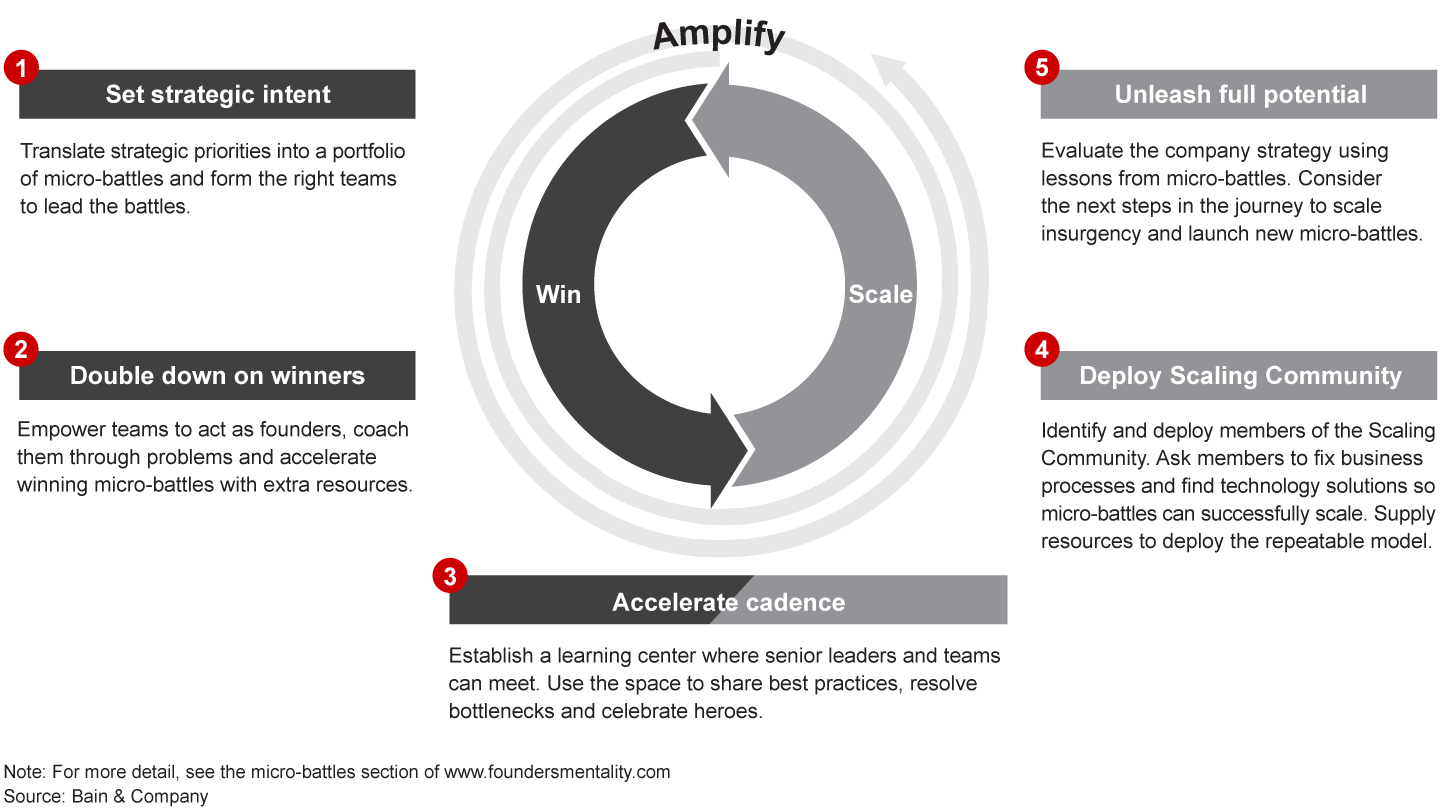
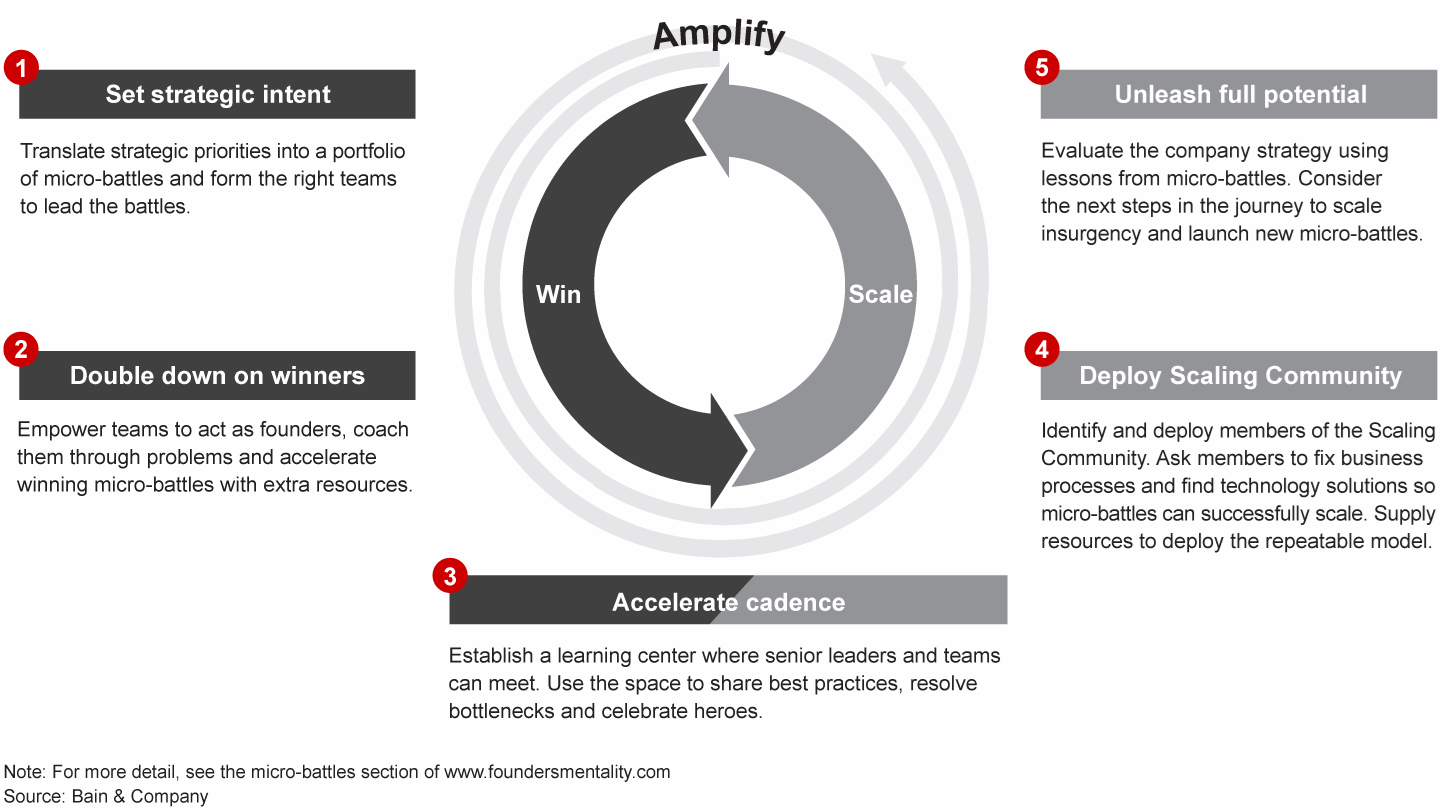
But the real power of micro-battles is that they challenge the fundamental behavior of the leadership team and prod executives to embrace a new way of working. Indeed, micro-battles demand more behavioral change from the top leadership team than from any other group in the company. Most leaders agree completely with the ambition to become a scale insurgent, but they have a harder time recognizing that their companies have become incumbents or struggling bureaucracies because the leaders have an incumbent or bureaucratic mindset. A big part of adopting micro-battles is showing a little humility; incumbent leadership got us into this mess and the same approach won't get us out of it. The decision to become a scale insurgent is implicitly a declaration of war on the routines and behaviors of the leaders themselves.
Earlier, we talked about the tyranny of functional excellence and how leadership loses itself in reviewing program after program as everybody clamors for resources. Micro-battles draw executive focus back to the strategic issues that really matter, gradually robbing oxygen from the countless other initiatives your customers don't care about. We also talked about the rise of the professional managerial class and its tendency to make problems bigger, not smaller, by focusing on ideology, not customers. The critical behavioral change here is to get out of the way.
The whole point of unleashing micro-battle teams on the company's top strategic priorities is to let them break through the usual corporate sclerosis and solve those problems quickly. The leadership team should cheer them on and coach them to act like founders, while ensuring their access to the best of the company's ecosystem. "Amplify" means, first and foremost, not doing the opposite—don't reduce, slow, diminish or stop the micro-battle team's efforts. The exam question is, "How do a group of senior incumbent leaders help a micro-battle leader get on with it and win the battle without a lot of interference or second-guessing?"
Micro-battles encourage behavioral change in three important areas:
- Leading behaviors. Getting this right means shedding the impulse to criticize, micromanage and issue top-down dicta. Top leaders instead show what it means to be a scale insurgent by letting teams take risks, learn from failure and claw their way to a solution. Often this means demonstrating how to make problems smaller by solving the specific, not debating the ideological. It means supporting teams by listening, coaching, giving and celebrating. Often it involves asking a fundamental question: Are we, as leaders, really acting as founders and owners, or are we in a "wait-and-see" mode, or, worse, adopting a protective stance and defending the status quo? The answer to this question is critically important because the example leaders set will amplify across the organization.
- Learning behaviors: Microsoft CEO Satya Nadella puts it this way: Leaders need to replace a "fixed" mindset with a "growth" mindset. They must be open to new ideas, not defensive of the status quo. In the micro-battles context, that means exploring without judgment what the teams are learning. It means shifting the focus from controlling to facilitating peer-to-peer learning and enabling collaboration across silos and business units. It means celebrating both victory and failure as opportunities to learn, while connecting the dots across micro-battles. How do we start recognizing patterns from battles and using these insights to get better?
- Scaling behaviors: Leaders running a micro-battle portfolio make a habit of asking the scaling question at every turn. But they also focus on two other questions: Are we as a leadership team slowing things down by what we're doing or saying? Or are we aligning around ways to accelerate and scale? Leaders have to fight the urge to question, bicker and stall. A scaling mindset involves ruthless focus on what's working to advance strategy and getting behind those initiatives with the company's full resources and attention.
For one large telecom company, this was a constant challenge. The company had a clear insurgent mission, the CEO and executive committee were committed to micro-battles, and they had accepted the value of role-modeling new behaviors at every interaction. Yet when competition heated up and the going got tough (as it inevitably does), this wasn't easy. They found themselves unconsciously slipping back into an old command-and-control mindset.
To reinforce the need to think like a coach, not a commander, the CEO made a pivotal decision. He pledged to mentor personally the franchise players who were leading each micro-battle. This meant making time for monthly coaching sessions, which kept the CEO focused on the micro-battles agenda, while championing the right behaviors and setting an example for the rest of the team.
Along the way, the top executives learned that behavioral change has to be hammered home repeatedly. They had to intentionally steer the monthly meetings away from PowerPoint activity updates and toward winning (how the prototype was delivering results for customers) and scaling (whether a repeatable model was evolving). They had to commit to ending meetings with clear calls to action: Executive committee members would pledge to remove specific impediments in the days ahead. Micro-battle teams would commit to actions for their next sprint and accelerating results. Executives would draw up a list of patterns across the micro-battles that require urgent leadership attention. They would also call out a roster of heroes who made things happen and lay plans to recognize their stories more broadly. Over time, the change began to stick.
Getting started
While micro-battles hold the potential to transform your company, the good news is that you can walk before you run. Commit to launch three micro-battles now. That's it. Agree to carve out three hours of a monthly executive meeting to review the results of those three battles. Learn through four cycles and then launch three more micro-battles, then six, then 12 more. Soon, you're more than a year into learning. You're finding that your micro-battle reviews take all day. You're focusing less on functional reporting and more on marketplace battles. You're spending less time as an executive team talking to each other and more time listening to the voices of your franchise players and customers. You're backing models that are both winning and repeatable, and succeeding in the marketplace. You're focused on deep behavioral change. You're on the journey to becoming a scale insurgent.
James Allen is a partner in Bain’s London office and coleader of the firm’s Global Strategy practice. Dunigan O’Keeffe is a partner in Bain’s Global Strategy practice and is based in San Francisco. Peter Slagt is a partner in the firm’s Global Results Delivery® practice and is based in Singapore.
Founder’s Mentality® and Results Delivery® are registered trademarks of Bain & Company, Inc.
Bain Micro-battles System℠ is a registered service mark of Bain & Company, Inc.
Scaling Community℠ is a service mark of Bain & Company, Inc.

Founder's Mentality
Fast-growing companies can become global leaders without losing the values that helped them succeed. Bain’s research explores how large incumbents can also reignite their growth by recapturing their Founder’s Mentality®.

Peter Slagt: How to Amplify Success in Micro-battles
In order for micro-battles to be effective, leaders need to ensure that micro-battle teams can flourish in their organizations.